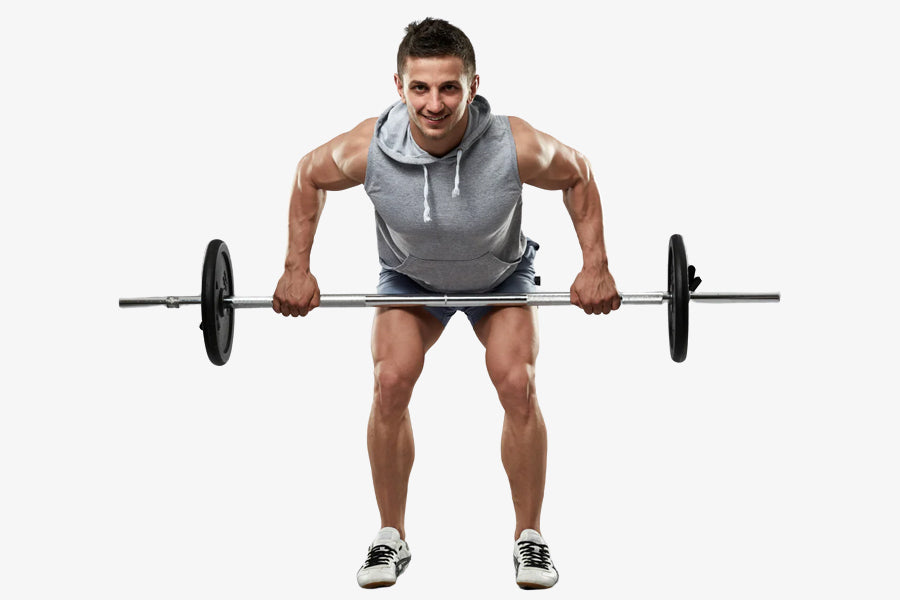Need an upper-body workout that will challenge and engage your whole body? Or do you love feeling the burn in your muscles after a good workout? Look no further than the Pendlay row exercises! This exercise is a great way to build strength, muscle mass, and power in your upper body. Plus, it's simple enough that anyone can do it.
Pendlay row is named after Olympic weightlifter Glenn Pendlay. It is a weighted row exercise that works the muscles in your back, shoulders, and arms and is a great way to improve your grip strength, build muscle, and increase your overall strength.
These exercises are also great for developing explosive power and improving athletic performance and can be performed with a barbell, dumbbell, or kettlebell. Pendlay row exercises are typically performed with a pronated grip (palms facing down) but can also be performed with a supinated grip (palms facing up) and a wide grip or a narrow grip.
You can perform them with high or low reps, but they are typically performed for 3-5 sets of 5-10 reps. You can incorporate these exercises as part of your full-body workout routine or a split routine.
So, who wants to know the details? Read on for tips on performing the Pendlay row safely and effectively, including its multiple benefits.
Related Article: 6 Best Upper Body Exercises to Increase Your Metabolism Fast
How to Do Pendlay Rows With Perfect Form

Step up to the bar with your feet about shoulder-width apart and start the lift. At this point, stoop forward and grab the bar about outside shoulder width.
Your knees should be slightly bent as you begin. Additionally, you should have a moderately straight back and a downward-facing gaze.
Quickly raise the bar from the floor toward your sternum from here. Your elbows should be spread to the sides at a 45-degree angle to your torso as you pull.
Directions
- Place your feet shoulder-width apart as you step up to the bar.
- Hold the bar with an outside-shoulder-width overhand grip.
- So that your back is parallel to the floor, slightly budge your knees.
- Straighten the bar out and raise it to your sternum.
- Before the following rep, bring the bar back to the ground and allow it to halt.
- For the required amount of reps, repeat.
Here are a few suggestions for good Pendlay row form.
- Try to maintain a flat back during the motion.
- Throughout the action, try to maintain roughly the exact angle of flexion in your knees.
- The bar should rest on your chest at or below the level of your nipples.
- Avoid arching your back forward.
- Never drive the weight up with your legs or push through them.
- Avoid bouncing the bar off the ground (start from a dead stop each rep)
Pendlay Rows Muscles Worked
The Pendlay row targets your entire body's main muscular groups. That will help you with more challenging exercises like deadlifts, squats, and weightlifting.
Latissimus Dorsi
Your lats are a thick, triangular-shaped muscle mass that runs almost the whole length of your back. The scapular depression and your arms' flexion (or tugging) include them. You use your lats whenever you pull something toward you.
Hamstrings
The fact that your legs won't be moving doesn't mean they won't be working, though. When performing the Pendlay row, your hamstrings isometrically support you as you bend over. Your hamstrings will receive a brief rest when the bar touches the floor in between reps, but if you're lifting heavy or doing a lot of repetitions, they'll still take a beating.
Spinal Erectors
During this bent-over row variation, your spinal erectors strive to support your spine because you are tilted during the whole exercise. This type of isometric back exercise can help you achieve a more powerful deadlift setup and pulling position, as well as any movement that involves lifting a load off the ground.
Benefits of Doing Pendlay Rows
The gains you can make with the Pendlay row are anything but minor for a "just" supplementary move.
Stronger and Larger Back
Training with volume, load, and concentrated contractions is crucial if you want to develop a strong back for cosmetic reasons or to carry over to other lifts.
In contrast to other back-specific exercises, the Pendlay row enables you to load the bar with reasonably substantial weight while (if appropriately executed) still requiring entire ranges of motion to enhance back hypertrophy.
Improved Squats and Deadlifts
For exercises like the deadlift, back and front squats, and the bench press, it's crucial to brace and tighten your back. Your back will be put under increased strain when you perform those exercises with heavier weights.
You should incorporate Pendlay rows into your regimen to ensure that your ability to support your back keeps up with the rest of the lift.
It would be best if you braced yourself every time you lift the bar since each rep must be performed from a complete stop on the floor. That is excellent preparation for heavier lifts.
Related Article: 10 Amazing Deadlift Variations for Beginners to Improve Your Pulls
Increased Pulling Skills
Performing the Pendlay row might be a high priority for strength athletes. It is especially true if your back and hamstrings lack postural strength. Both static and concentric strength, which are required for the snatch, clean & jerk, and breaking through sticking spots in those particular lifts, can be increased with the Pendlay row.
Powerlifters who perform pendlay rows may benefit from improved lower back and upper back strength in the squat and deadlift.
Pendlay Row Variations
It might happen that the only weights in your home gym are dumbbells or kettlebells or you might be fortunate to have access to a commercial gym. So either way, here are some Pendlay row variations you may perform using various tools.
Smith Machine Pendlay Row

Pendlay rows with Smith machines should be executed precisely as those using barbells. The bar moves on a fixed course because of the guide rails, which is the only difference.
It may be more challenging to do a pure Pendlay row on some Smith machine bars since they move over inclined rails. This exercise is best carried out on a Smith machine with a straight up and down the route.
Dumbbell Pendlay Row

Using dumbbells while performing the Pendlay row is another variation. However, because you have to control two weights instead of one, you could find using dumbbells more difficult if you've never done this exercise. Additionally, because of the narrow diameter of dumbbells, you must first lean forward more.
Kettlebell Pendlay Row

Kettlebell handles are raised slightly above the floor in comparison to dumbbell grips. Therefore, arranging your body in the correct beginning posture is simpler if you have this equipment.
Common Mistakes
The Pendlay row is designed to be difficult; you must keep a tight hip hinge throughout the lift. Additionally, you won't gain anything from the momentum to assist you in starting each rep. You're bound to commit typical errors whenever an exercise is created to up the ante of a classic (in this example, the bent-over row).
Back Angle
There are undoubtedly situations where faking your form will increase your gains, but this is typically not the case with an unsupported hinge. You may try to yank with your arms, much as you might be tempted to stand up straight during the Pendlay row.
You can also attempt pulling up with your back by elevating your shoulders above your hips. Your back may probably jerk upright due to the momentum before slipping back into its optimal position. Additionally, you won't be preserving the strength of your hip hinge, which is necessary for the Pendlay row to be as efficient as possible.
Lock in your Pendlay row form with light weight before moving your load forward to prevent this. Packing your shoulders back and down will help you prepare for each rep. Then, to start the pull, clench your shoulder blades together. Pay attention to maintaining pushed-back hips as well.
Flaring Your Elbows
During this lift, it's acceptable if your elbows stay partially by your sides. To accommodate the pull, lifters with longer arms may need to slant their elbows out slightly.
However, completely "chicken-winging" your elbows out to the sides may compromise the stability of your shoulders. Additionally, your shoulders and arms will receive more attention than your lats.
Lighten the load until the issue passes if you find yourself yanking the bar and spreading your elbows to the sides. You can also try cueing yourself to pull the bar to your hips or to put your elbows in your pockets. Try a few different ones until you discover one that suits you.
Going Too Heavy
You've undoubtedly put too many plates on the bar if you need to increase your back angle or yank the weight up sharply. The Pendlay row's ability to humble you is a good thing. You can increase your number of plates more rapidly by transferring less weight while maintaining flawless form.
Try to maintain the same load while improving the quality of reps you can complete rather than concentrating on raising your load. Return and gradually add extra weight until you reach your goal weight.
FAQs
1. How effective are Pendlay rows?
The Pendlay row can assist you in developing a more muscular back by promoting muscle growth throughout your upper and lower back. Pendlay rows work your latissimus dorsi, trapezius, rhomboids, spinal erectors, and other back muscles when performed correctly.
2. Are Pendlay rows safer?
There is no definitive answer to this question, as Pendlay rows can be performed with a greater or lesser amount of safety, depending on how they are executed.
Generally speaking, Pendlay rows are a safer variation of the traditional bent-over row, as they allow for a greater range of motion and decrease the risk of spinal compression. However, if performed incorrectly, Pendlay rows can still lead to injury.
3. Why is it called a Pendlay row?
The Pendlay row is so named because Olympic weightlifting champion Glenn Pendlay invented it.
4. Does Pendlay row use legs?
Pendlay row is a compound exercise and uses different muscles, including forearms, legs, abs, glutes, and deltoids, besides the muscle it targets.
The Bottom Line
The Pendlay row is an excellent exercise for building strength and size in the back muscles. It can be done with a barbell or dumbbell and is an excellent addition to any workout routine. The benefits of the Pendlay row include a stronger and larger back, increased pulling skills, improved squat and deadlift technique, and reduced risk of injury.
Remember to keep your core engaged throughout the entire movement to avoid injury. Try adding the Pendlay row to your next workout and see how it can help you build a strong, healthy back!
 Skip to content
Skip to content











